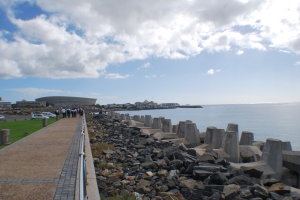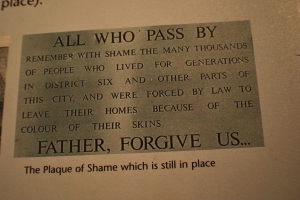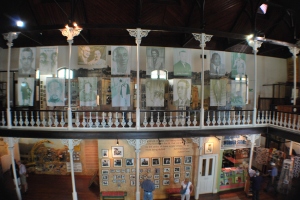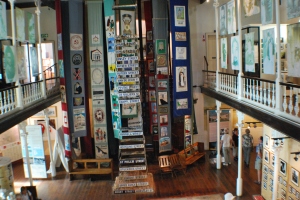
Cape Town is a beautiful city. Beautiful shopping malls that stock exquisite goods. Designer suits and other wear, fashionable footwear, chic and expensive eyewear and top of the range automobiles. The water front mall and accompanying restaurants and hotels with well manicured lawns adds the splendor of this classy city with the world-famous Table Mountain as its backdrop.
The glamour Cape of Good Hope does not end there. If you come from Nairobi or Lagos the traffic jams are a nightmare, you will certainly notice their wide roads. The continent is fraught with these kinds of cities with despicable traffic jams. The traffic jams prompted Malian reggae star Askia Modibo to immortalize them with his song “Circulation de Bamako” that describes the nightmare in Bamako as “tres tres dangerous!”
This is the reason you will not fail to notice that the wide roads are well managed. The traffic lights are automated and unlike Nairobi, there are no policemen to manage the flow of traffic at roundabout, albeit these are very minimal. There is an occasional pile-up especially when there is an accident as happened when we were coming from Gugulethu but on normal occasion, it is smooth sailing.

The road network is striking and the City is reaping benefits of hosting several FIFA World Cup games when the tournament was held in South Africa in 2010. I was there a year to the tournament and the transformation, especially to their international airport, was remarkable. The infrastructural foundation that came with the tournament will be felt for many years to come.
Commuters using public transport have a number of options. There are scheduled buses that are not only cheap but also prompt. My short ride in one of them from the city centre to the waterfront, where the press conference with the artists scheduled to perform at the 2012 Cape Town International Jazz Festival were, was memorable. If these are buses that the Nairobi Metropolitan Ministry had in mind to operate with the CBD, then this is a good idea.
A walk around the city, at least the tourist side, is memorable. The boulevards and the shopping arcades are like any that you will see in any Western cities. And you will be forgiven to imagine that you are in one of those cities.
However behind this façade, lies a dark (his)story. A story of displacement, “humiliation, bitterness” and “fragmentation of the identity and heritage of particular community” that is best remembered with what happened at District Six.
The memory of what happened at District Six is to be found at an old church turned into a museum tacked at the junction of Buitenkant Street and Caledon Street. The Museum portrays the history of apartheid and its effects on ordinary people through an intimate look at their personal stories. It is a place that is worth visiting.
Bra Hugh Masekela, the legendary South African trumpeter, immortalized those stories in a memorable number titled District Six off his equally unforgettable 2005 album titled Revival. You wouldn’t listen and experience District Six stories and fail to be moved.
At the entrance to the Museum, a Plaque of Shame welcomes you with succinct message. “All who pass by,” the plaque reads, “Remember with shame the many thousands of people who lived for generations in District Six and other parts of the city, and were forced by law to leave their homes because of the colour of their skins. [Father, Forgive us]………………The Plaque of Shame.”

District Six was named the sixth district of Cape Town in 1867. Established as a vibrant mixed community of freed slaves, merchants, artisans, labourers and immigrants, it was closely linked to the city and port. By the beginning of the 20th century, the process of removals and marginalization had started.
The report of the Commission of Inquiry into Matter Relating to the Coloured Population indicated that the declaration of District Six as a white group area in 1966 was anticipated by urban “renewal” plans as early as 1935.
The report noted: “In 1935, the South African Railways, who managed South African harbours, announced a plan to expand Cape Town harbor. Plans were set in motion for the construction of Duncan Dock and re-planning of the surrounding city including District Six. The re-planning of Cape Town followed the thinking of the famous Swiss planner, Le Corbusier, who urged that modern city could not function properly unless its “accident” layout was replaced with a standard geometrical plan.”
The reported pointed out that proposals were made for Cape Town following this thinking which placed emphasis on the total re-organisation of the city’s centre: “We must concentrate our first activities at the city centre, so that freedom of movement, accessibility and breathing space can be restored where they are vital. It is possible to achieve this radical re-organisation by dramatic methods only; by a fresh start on cleared ground…. This ruthless eradication directed towards revitalizing process we have, following Le Corbusier’s lead, named the Surgical method…. Through surgery we must create order….”
In February 1966, P.W. Botha, then Minister of Community Development formally proclaimed District Six a “white” group area. The authority for this proclamation came from Group Areas Act which had been passed in 1950. Over a period of fifteen years, more than 60,000 people were given notice to give up their homes and to move to new townships on the Cape Flats, some of which were named, cynically, after streets in District Six.

The Group’s Areas Act instituted the division of urban areas into separated townships, which were designated to divide and isolate communities. The basic amenities necessary for a decent life were absent in these new townships. Poorly constructed working class townships were built separated by buffer strips consisting of freeways, polluted rivers and vleis, and strategically placed military land and golf courses. In District Six, apartheid‘s grand scheme was to remove 35,000 people from the city’s core to its distant periphery.
By the beginning of 1984, the destruction of District Six was complete. Aside from a few buildings the landscape was stripped and cleared. In the early 80s, building operations began with two structures symbolic of the new order which had come to impose its will on the people and landscape of District Six.
The election of a new government in 1994 brought hope to former residents of the possibility of restitution of their rights. After a series of struggles, former residents, the City Council and the Department of Lands Affairs reached an agreement that a consultative process of compensation for the loss of property and tenancy rights would be undertaken. It was also agreed that the organizations of the people would involved in a collaborative redevelopment process.

Within the Museum, survivors and their descendants have recreated many things. Their reasons to remember and keep the memory of what transpired are worth mentioning. “Remember District Six. Remember racism which took away our homes and our livelihood and which sought to steal away our humanity…………Remember also our humanity. Remember also our will to live, to hold fast to that which marks us as human beings; our generosity, our love of justice and care for each other………………….In remembering we do not want to recreate District Six but to work with its memory: of hurts inflicted and received, of loss, achievements and of shames. We wish to remember so that we can all, together and by ourselves, rebuild a city which belongs to all of us, in which all of us can live, not as races but as people.”
I couldn’t help thinking about our own experiences and especially now that the Truth, Justice and Reconciliation Commission, is just about to conclude its work. I remembered the Wagalla massacre, the Nyayo House torture chambers, the displacement that accompanied the 1992, 1997 and 2007 general elections. How have we used the “memory: of hurts inflicted and received, of loss, achievements and of shames, to rebuild a city ‘country,’ which belongs to all of us, in which all of us can live, not as races ‘tribes’ but as people.”
While contributing to his personal memory to the Museum with a permanent exhibition, Roderick Sauls, captured the necessity of establishing such a establishment to remind mankind of the kind of narcissism they are capable. That in spite of the opulence man can be impious.
“In my determination to remember,” Roderick wrote in 1999, “I am constantly reminded of Milan Kundera’s famous dictum from ‘The Book of Laughter & Forgetting:’ “the struggle of man against power is the struggle of memory against forgetting.’”
It is a bitter history juxtaposed with the beauty and splendors of Cape Town. A bitter history that has however, not been swept under the carpet. Through the work of the Museum that has now been extended the bitter history now co-exists with the beauty of the Mother City.


http://www.the-star.co.ke/lifestyle/128-lifestyle/72873-cape-town-a-dark-past-behind-the-facade
Never and never forget the past to not commit the same stupid mistakes in the present (somewhere human still doing the same mistakes) and above all in the future when we will not be anymore around (thanks to God) but better and wiser generations (our son, grandson, etc) will live in this wonderful world, also in Cape Town which is for 50% of the world population still the bottom of the world, nothing else!!!!
It is clear of course that the generation 35-65 years old are hopeless and cannot change anything (civil society and political classes in toto)
Watch at many (too much) examples around you and meditate!!!!
Ahhh, so nice to see and hear about your country from a totally different perspective. I loved this article. Well done, Kimani
Thank you Harriet. I hope I will be back there some times in the future. And you are welcome to Kenya.
Thanks, Kimani.;)
com provides an indepth look at all fifty States that make up this Great
Country of ours and their five largest cities. The list of lakes and ponds found
in the State of Massachusetts includes Lake Ashmere near Pittsfield, Lake Attitash, and Indian Head Park Beach, in Merrimac, Lake Boon with four basins in Stowe and Hudson, Brooks Pond that forms the headwaters of the Five Mile River near North Brookfield,
Lake Lashaway, near East Brookfield, that is brown
in color and warm in the summertime, Lake Buel, in Great Barrington, with
more than one hundred Summer homes, Lake Chaubunagungamaug,
in Webster, with a Native American Indian name meaning “fishing place at the boundaries,” Lake Cochichewick in North Andover,
Lake Cochituate, in Natick, on the peninsula that houses the United States Army Soldier System Center, Pegan Cove
Park, and the Cochituate State Park, Follins Pond, a brackish lake on Cape
Cod, Great Herring Pond in Plymouth, Haughton’s Pond, in Milton, a spring-fed, glacially-formed kettle hole, Mashpee Pond and Wakely Pond, adjoining bodies of water in Sandwich, Cape Cod’s largest
fresh water pond when combined together, Lake
Massapoag, in Sharon, the home of a major 19th Century ice company and a minor Summer
resort area, Lake Onota, in Pittsfield, with large 20th
Century-built mansions, Pranker’s Pond in Saugus, Lake Quannapowitt, in Wakefield, the site of many 5K to Ultra Marathon races, Lake Quinsigamond, in Worcester, with eight privately owned islands, Lake Rico, in the Massasoit State Park at Taunton, containing many coves, islands, and forests, Lake Sabbatia, in the Taunton Area of Critical Environmental Concern known as the Canoe River Aquifer, Sargent’s Pond,
in Brookline, on the National Register of Historic Places, Tuxbury Pond at Amesbury on the Massachusetts
and New Hampshire State Line, a large Summer Camp resort,
Watson Pond, in Taunton, popular for ice fishing,
Winnecunnet Pond, in Norton, that has a famous,
and serious, weed problem, North and South Watuppa Ponds, in Fall River and Westport, connected by a narrow channel they are the second and third largest naturally-occurring bodies
of water in the State, Wenham Lake, in Beverly, a Colonial Period
important alewife fishing location, Lake Wyola and dam, in Shutesbury,
that has supported several mills from the 1880s on, Lewis Lake
in Winthrop, and the Quabbin Reservoir, the largest lake in Massachusetts, that
supports Boston and forty other communities. Don’t let him do too much for you or spend too much, (even if he volunteers).